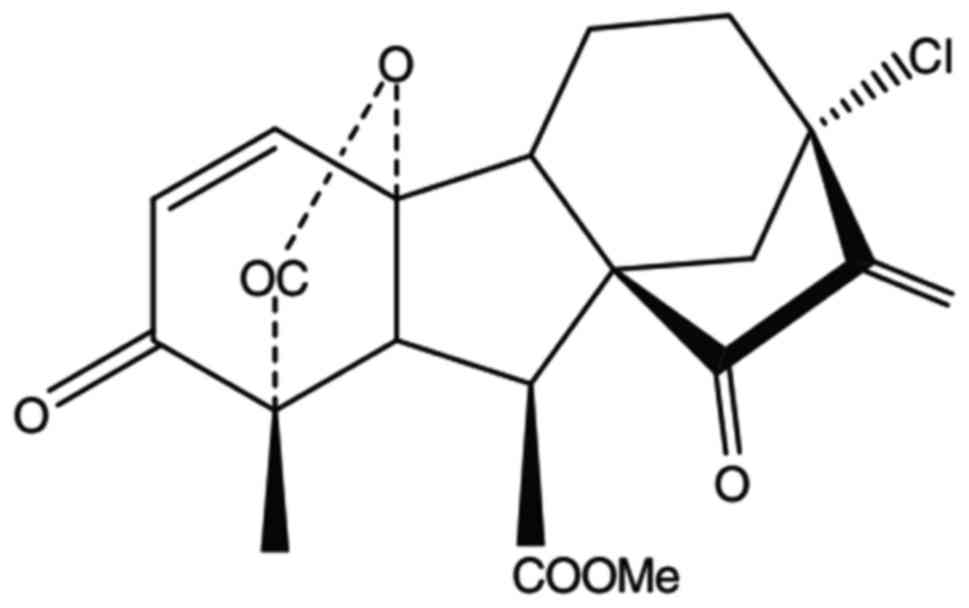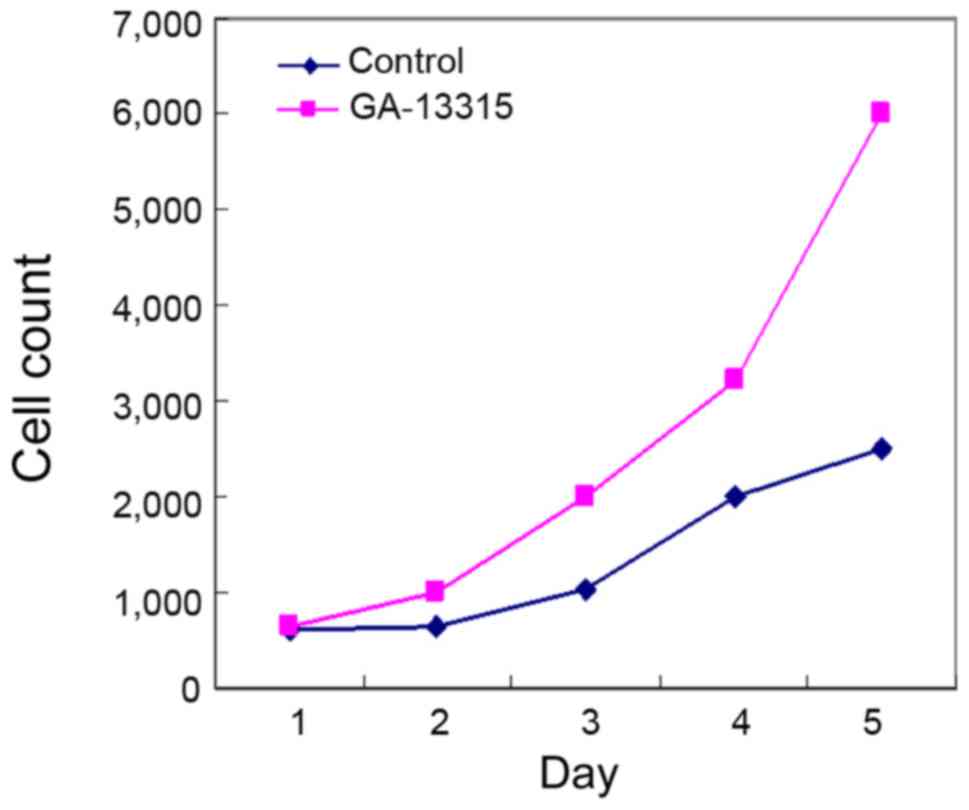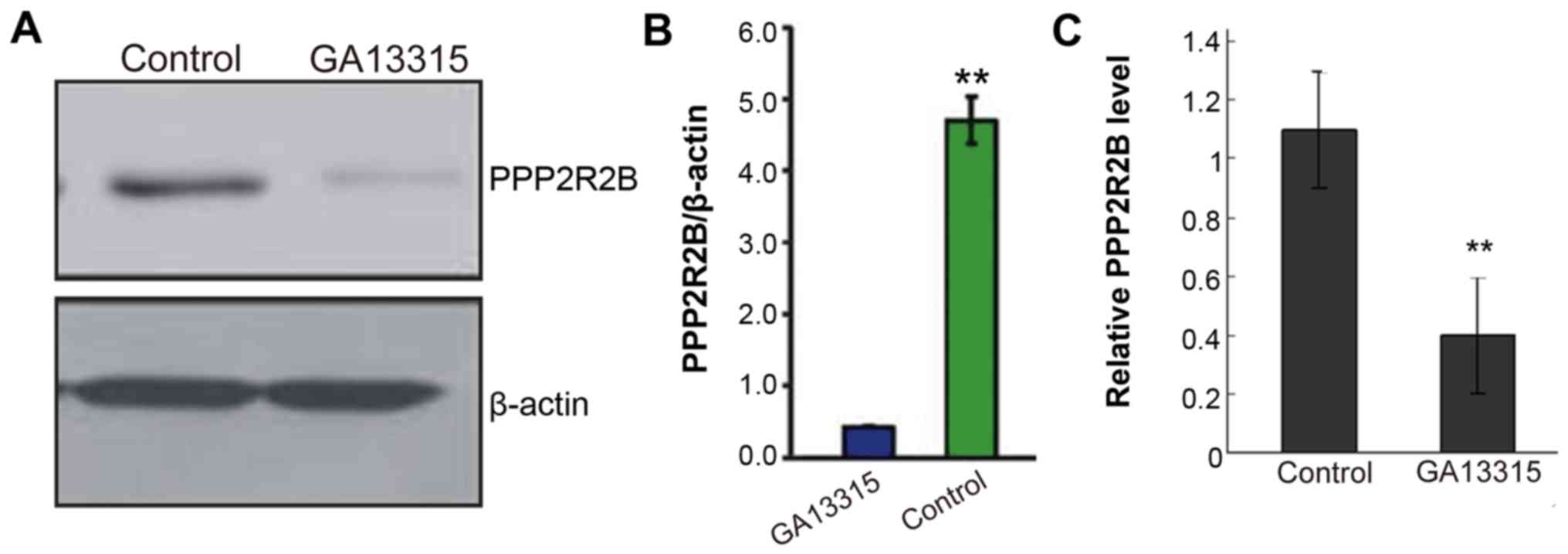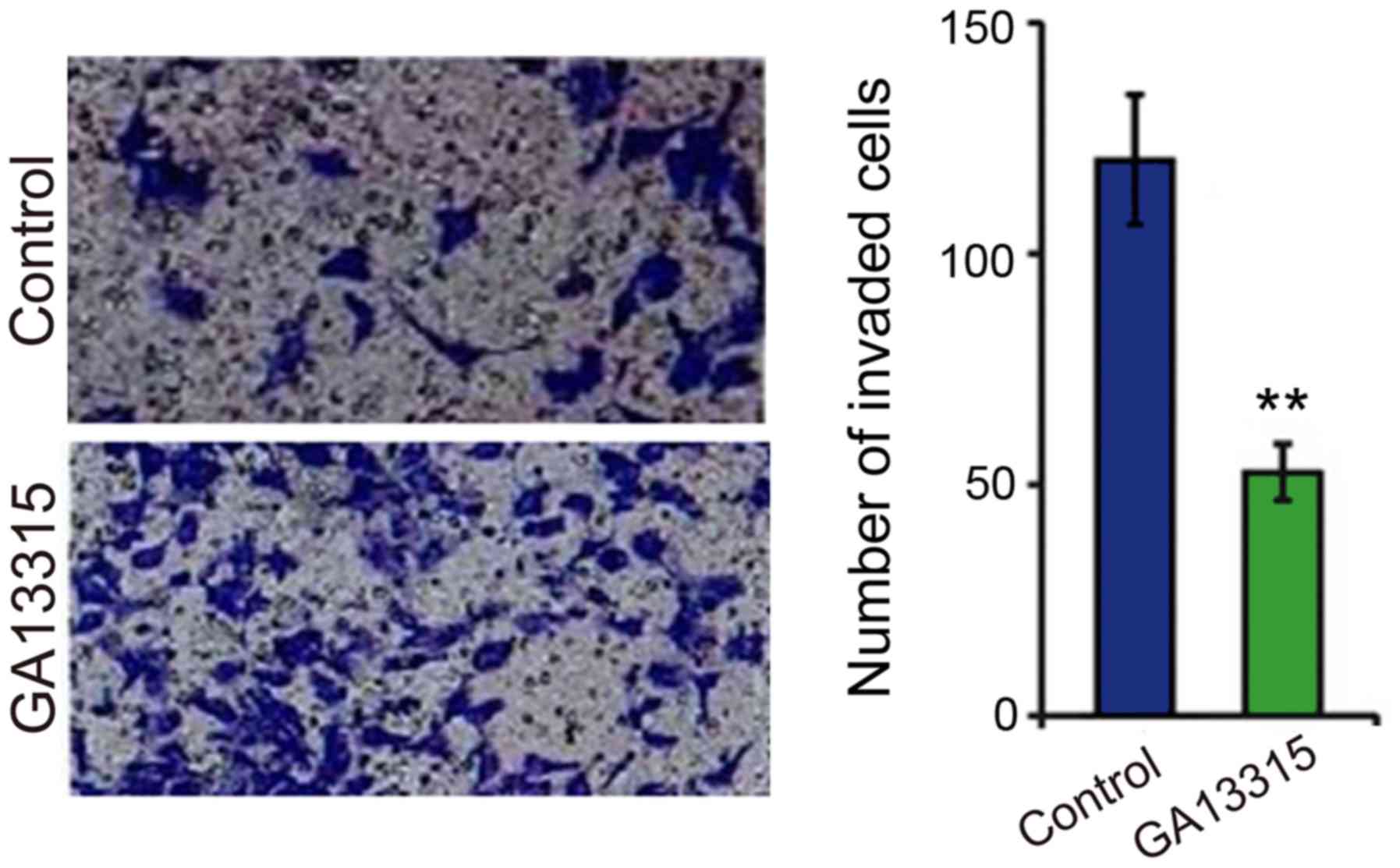Effects and mechanism of GA-13315 on the proliferation and apoptosis of KB cells in oral cancer
- Authors:
- Published online on: May 29, 2017 https://doi.org/10.3892/ol.2017.6279
- Pages: 1460-1463
-
Copyright: © Shen et al. This is an open access article distributed under the terms of Creative Commons Attribution License.
Abstract
Introduction
Oral cancer is the generic term for a malignant tumor of the oral cavity. Most of these types of cancers are considered squamous cell carcinomas, i.e., mucosal variations (1). Oral cancer generally includes gingival and tongue cancer, and is commonly seen in the head and neck (2). Most types of oral cancer are related to unhealthy living habits, such as the oral use of tobacco and betel leaf. Since the space of the oral cavity is small but the blood supply is rich, with more lymph distribution, oral cancer is easily transferred at an early stage. This may cause certain challenges regarding treatment (3,4).
In the past, synthetic gibberellin was widely used as the conditioning agent for plant growth (5). Synthetics of α,β-unsaturated ketone unit with gibberellin revealed the antitumor activity of the gibberellin ramification (6). GA-13315 is a chemical compound that includes α,β-unsaturated ketone (Fig. 1). Some research shows that GA-133315 has antitumor properties in rats with xenotransplantation of tumor cells for non-small cell lung cancer (A549 cells), but the antitumor effect of GA-13315 has not been determined yet (7). More recent research shows that GA-13315 offers good treatment for breast cancer in patients with multidrug-resistant, which is exerted through the expression of P-glycoprotein (ABCB1). In order to investigate the effect on oral cancer, we studied the effect mechanism through the use of cancer cell line H1299 in this study.
Materials and methods
For the preparation of the cell suspension with high activity, the KB cell concentration was adjusted to 5×106-1×107/ml by 10% FCS RPMI-1640 (Sigma-Aldrich, St. Louis, MO, USA). A 5–50 µl glass tube was prepared to contain a 40 µl cell suspension after centrifugation at 1,050 × g for 5 min. A scrubbing solution (Keygen, Nanjing, China) was used to wash the 4°C inactivated rabbit serum twice for 30 min, at which time a 2 ml scrubbing solution was added. The centrifugal parameter was set as 850 × g for 5 min; wash at 4°C of 50 µl rabbit anti-rat fluorescent marker (Biosharp, Hefei, China) for 30 min; fixing after washing twice; the film was observed under a light microscope (Labconco, Kansas City, MO, USA).
Detection of MMT cell activity
An MTT experiment was used to detect cell activity. The suspension of 160 µl with 8×103/µl cells were inoculated into a 96-well plate for cell contact overnight. In order to detect the cell toxicity of GA-13315, GA-13315 (Sigma-Aldrich, San Francisco, CA, USA) was added to the cell culture medium with the total amount of 200 µl.
Cells were cultured for 48 h in a medium with GA-13315, then washed and placed in the RIPA lysis buffer (Beyotime, Shanghai, China) with 1 mM PMSF, 1 µg/ml trasylol and 0.5 µg/ml eupeptin for pyrolysis on ice. An equivalent cell lysis solution (20 µg proteins; Beyotime) was separated by sodium dodecyl sulfate-polyacrylamide gel electrophoresis and transfected to the polyvinylidene fluoride film (KeyGen). TBST (10 mM Tris-HCl, 150 mM NaCl, and 0.1% Tween-20, pH 8.0) was sealed for 1 h under room temperature using 5% skim milk. After being incubated overnight using rabbit polyclonal PPP2R2B antibody (dilution, 1:200; cat. no. ab137609) under 4°C, it was washed and hatched for 2 h at 25 °C using secondary goat anti-rabbit (HRP) IgG antibody (dilution, 1:2,000; cat. no. ab6721) (both from Abcam, Cambridge, MA, USA). It was visually tested by enhanced western blotting and phototope™-HRP visual kits (Cell Signaling Technology, Danvers, MA, USA). FluorChem E system (ProteinSimple, San Jose, CA, USA) was used to analyze imaging. ImageJ sofware (version X; Media Cybernetics, Silver Springs, MD, USA) was used for quantization of protein relative expression by referring to β-actin.
Cells were seeded overnight in a 6-well plate (Corning Inc., Corning, NY, USA) based on the density of 1×105 cells/plate. GA13315 with different doses was used for simulation, while 0.1% DMSO was used for control. It was continuously cultured for 48 h under 37°C. TRIzol reagent (Thermo Fisher Scientific, Waltham, MA, USA) was used for cellular total RNA extraction. Then, 1 µg of total RNA was used for cDNA first strand synthesis. M-MLV First Strand kits were used for synthesis. ABI PRISM® 7500 Real-Time PCR system and SYBR® Premix Select Master Mix kit (Thermo Fisher Scientific) were used for amplification of the genes of interest. β-actin was used as an internal reference. Specific primers were as follows: β-actin forward, 5′-CACCTTCTACAATGAGCTGCGTGTG-3′ and reverse, 5′-ATAGCACAGCCTGGATAGCAACGTAC-3′; forward, 5′-AGTAGTAGTAGTTGTGAGTGTGT-3′ and reverse, 5′-AAACAACCACAACAAAATAATACC-3′. The thermal cycle program was as follows: At 50°C for 2 min, at 95°C for 2 min, at 95°C for 15 sec, 45 cycles, at 55°C for 30 sec, at 72°C for 1 min. Specific melting curves were adopted to describe each reaction. The mean value of mRNA expression was calculated for the genes of interest in each group. ΔCq = Cqtarget gene - Cqβ-actin; -ΔΔCq = -(ΔCqMCF-7/adr-ΔCqMCF-7).
A millipore filtration culture chamber or double-chamber co-culture system (Corning Inc.) was used with a cell culture density of 1×106. The experimental procedures were conducted on built-in standard specifications.
Statistical analysis
SPSS 20.0 statistical analysis software (IBM SPSS, Armonk, NY, USA) was used to analyze collected data. All measurement data are presented as mean ± standard deviation. SPSS 17.0 (SPSS, Inc., Chicago, IL, USA) software was used for processing. Repeatedly measured data via the ANOVA method was adopted for statistical treatment. The t-test of two independent samples was used for measurement data between groups, and the paired t-test was used for intra-group comparison. The χ2 test was used for enumeration data. P<0.05 was considered to indicate a statistically significant difference.
Results
KB cell viability was tested by MMT in the treatment group. It was found that the cell viability significantly decreased after being treated by GA-13315 for 48 h. The difference was statistically significant (P<0.05) as compared to the control group (Fig. 2).
Decreased KB apoptosis after treatment with GA13315
Flow cytometry was used to test cell apoptosis between the two groups. The results showed that KB apoptosis significantly increased after being treated by GA13315. The difference was statistically significant (P<0.05) as compared to the control group (Fig. 3).
GA-13315 promotes H1299 apoptosis via downregulating PPP2R2B
Western blotting and quantitative polymerase chain reaction (qPCR) tests found that PPP2R2B expression among cells in the treatment group was significantly lower than that of the control group (Fig. 4). The difference was statistically significant (P<0.05).
GA13315 lowers the cell invasion ability
After cell invasion was tested by Transwell migration assay between the two groups, the results showed that KB cell invasion ability was significantly decreased after treatment with GA-13315. The difference was statistically significant (P<0.05) as compared to the control group (Fig. 5).
Discussion
Oral cancer is a malignant tumor commonly seen in the head and neck region, which is ranked with oropharyngeal cancer in the top six of systematic malignant tumors. In some high-prevalence areas, new cases account for 25% of male malignant tumors every year (1). Treatments for patients with oral cancer often cause dysfunction of important organs, leading to unclear speaking, dysphagia and eating disorders, as well as changes in facial appearance and impacts on quality of life. Although oral cancer is not listed in the top 10 of malignant tumors, its morbidity and mortality cannot be ignored. According to global statistics in 2008, new oral cancer cases were approximately 274,000 and annual cases of death were 127,000, 2/3 of which were reported in 40–60-year-old adults. Also, 2/3 of the cases were in developing countries. It should be noted that oral cancer itself and its treatment course usually cause functional injuries to vital organs and facial feature damage, thereby seriously affecting patients' social communications (8–10). GA-13315 is a chemical compound containing α,β-unsaturated ketone. In previous research of A549 tumor cells, GA-13315 reduced the expression of blood coagulation factor VIII, microvessel density and vascular endothelial growth factors. This indicates that it plays a role in anti-angiogenesis. These results show that GA-13315 has activities of anti-angiogenesis that contribute to the development of anticancer characteristics (11,12). Therefore, we believe that GA-13315 has certain antitumor effects.
The PPP2R2B gene belongs to phosphatase II regulation subunit B. Protein phosphatase 2 is one of four major types of serine/threonine phosphatases, and it plays important roles in cell growth and division (13). It consists of a common heterogeneous core enzyme, a catalyst subunit and a constant adjusting subunit. Various kinds of adjusting subunits play their own roles (14). Some research has found that the genetic defect in the 5′UTR region may lead to rare type 12 autosomal dominant spinocerebellar ataxias (15). Moreover, PPP2R2B methylation may be associated with survival and prognosis in patients with gliomas (16). In tumor cell proliferation and apoptosis, the mechanism of PPP2R2B remains unclear. In the present study, we found that PPP2R2B expression of H1299 cells is significantly decreased after being treated by GA-13315. The difference is statistically significant (P<0.05) as compared to the control group. We believe that GA-13315 may increase apoptosis in oral cancer cells via regulating PPP2R2B and does show a correlation to dosage. This biological effect is completed via downregulating PPP2R2B.
References
|
Warnakulasuriya S: Living with oral cancer: Epidemiology with particular reference to prevalence and life-style changes that influence survival. Oral Oncol. 46:407–410. 2010. View Article : Google Scholar : PubMed/NCBI | |
|
Haron N, Zain RB, Nabillah WM, Saleh A, Kallarakkal TG, Ramanathan A, Sinon SH Mohd, Razak I Abdul and Cheong SC: Mobile phone imaging in low resource settings for early detection of oral cancer and concordance with clinical oral examination. Telemed J E Health. Aug 19–2016.(Epub ahead of print). PubMed/NCBI | |
|
Bajpai M, Arora M and Chandolia B: Bioimpedance for Oral Cancer Detection in Clinical Practice and its Applicability in Developing Nations. J Coll Physicians Surg Pak. 26:7212016.PubMed/NCBI | |
|
Ishikawa S, Sugimoto M, Kitabatake K, Sugano A, Nakamura M, Kaneko M, Ota S, Hiwatari K, Enomoto A, Soga T, et al: Identification of salivary metabolomic biomarkers for oral cancer screening. Sci Rep. 6:315202016. View Article : Google Scholar : PubMed/NCBI | |
|
Petersen PE: Oral cancer prevention and control - the approach of the World Health Organization. Oral Oncol. 45:454–460. 2009. View Article : Google Scholar : PubMed/NCBI | |
|
Bömke C and Tudzynski B: Diversity, regulation, and evolution of the gibberellin biosynthetic pathway in fungi compared to plants and bacteria. Phytochemistry. 70:1876–1893. 2009. View Article : Google Scholar : PubMed/NCBI | |
|
Chen J, Sun Z, Zhang Y, Zeng X, Qing C, Liu J, Li L and Zhang H: Synthesis of gibberellin derivatives with anti-tumor bioactivities. Bioorg Med Chem Lett. 19:5496–5499. 2009. View Article : Google Scholar : PubMed/NCBI | |
|
Zhang Y, Zhang H, Chen J, Zhao H, Zeng X, Zhang H and Qing C: Antitumor and antiangiogenic effects of GA-13315, a gibberellin derivative. Invest New Drugs. 30:8–16. 2012. View Article : Google Scholar : PubMed/NCBI | |
|
Conway DI, Petticrew M, Marlborough H, Berthiller J, Hashibe M and Macpherson LM: Socioeconomic inequalities and oral cancer risk: A systematic review and meta-analysis of case-control studies. Int J Cancer. 122:2811–2819. 2008. View Article : Google Scholar : PubMed/NCBI | |
|
Petti S: Lifestyle risk factors for oral cancer. Oral Oncol. 45:340–350. 2009. View Article : Google Scholar : PubMed/NCBI | |
|
Mo J, Kang M, Ye JX, Chen JB, Zhang HB and Qing C: Gibberellin derivative GA-13315 sensitizes multidrug-resistant cancer cells by antagonizing ABCB1 while agonizes ABCC1. Cancer Chemother Pharmacol. 78:51–61. 2016. View Article : Google Scholar : PubMed/NCBI | |
|
Zhang Y, Zhang H, Chen J, Zhao H, Zeng X, Zhang H and Qing C: Antitumor and antiangiogenic effects of GA-13315, a gibberellin derivative. Invest New Drugs. 30:8–16. 2012. View Article : Google Scholar : PubMed/NCBI | |
|
Mayer RE, Hendrix P, Cron P, Matthies R, Stone SR, Goris J, Merlevede W, Hofsteenge J and Hemmings BA: Structure of the 55-kDa regulatory subunit of protein phosphatase 2A: Evidence for a neuronal-specific isoform. Biochemistry. 30:3589–3597. 1991. View Article : Google Scholar : PubMed/NCBI | |
|
Holmes SE, O'Hearn EE, McInnis MG, Gorelick-Feldman DA, Kleiderlein JJ, Callahan C, Kwak NG, Ingersoll-Ashworth RG, Sherr M, Sumner AJ, et al: Expansion of a novel CAG trinucleotide repeat in the 5′ region of PPP2R2B is associated with SCA12. Nat Genet. 23:391–392. 1999. View Article : Google Scholar : PubMed/NCBI | |
|
Marmorstein LY, McLaughlin PJ, Stanton JB, Yan L, Crabb JW and Marmorstein AD: Bestrophin interacts physically and functionally with protein phosphatase 2A. J Biol Chem. 277:30591–30597. 2002. View Article : Google Scholar : PubMed/NCBI | |
|
Majchrzak-Celińska A, Słocińska M, Barciszewska AM, Nowak S and Baer-Dubowska W: Wnt pathway antagonists, SFRP1, SFRP2, SOX17, and PPP2R2B, are methylated in gliomas and SFRP1 methylation predicts shorter survival. J Appl Genet. 57:189–197. 2016. View Article : Google Scholar : PubMed/NCBI |














